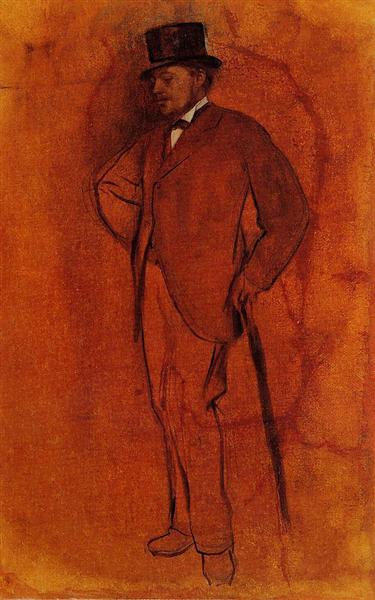Descriere
Lucrarea „Achille de Gas” de Edgar Degas, pictată în 1872, este ridicată ca o mărturie a talentului unic al artistului în reprezentarea figurii umane, precum și capacitatea sa de a surprinde intimitatea relațiilor de familie. Pictura prezintă un tânăr, probabil Achille de Gas, care este nepotul pictorului și un Yegüero recunoscut, cufundat într -o reflecție care evocă o legătură emoțională profundă. Acest portret se remarcă în corpul de lucru al lui Degas pentru abordarea sa aproape intimă în portretul familiei, distanțându -se de cele mai formale reprezentări ale vremii sale.
Degas, cunoscut pentru interesul său pentru capturarea mișcării și a vieții de zi cu zi, folosește o compoziție care pare împrăștiată, dar în același timp se simte coezivă. Tânărul este în centrul lucrării, înconjurat de un fundal subtil care nu atrage atenția privitorului, practic iluminată de o lumină moale care îi evidențiază fața. Paleta de culori este predominant pământească, cu tonuri bej și maro care înconjoară personajul într -o atmosferă de căldură și reflecție. Această alegere cromatică nu numai că servește la consolidarea intimității imaginii, dar stabilește și o legătură vizuală cu privitorul, care este invitat să contemple gândurile replicantului.
Tehnica Degas în utilizarea luminii și a umbrei este deosebit de notabilă în această lucrare. Lumina moale care scaldă chipul tânărului creează un sentiment de calm și contemplare. Lucrările perii liberi și textura obținută în haine, iar fundalul sugerează mișcare și viață, caracteristici constante în multe dintre lucrările lor. Această abordare practic impresionistă în execuție diferă de precizia clasică, subliniind interesul lui Degas pentru o reprezentare mai dinamică și mai puțin statică.
Prin acest portret, privitorul poate percepe un dialog subtil între artist și modelul său. Aspectul tânărului, îndepărtat și reflexiv, invită contemplarea observatorului, care nu poate evita să întrebe despre lumea internă a portretizată și legătura sa cu profesorul. Relația dintre Degas și nepotul său nu este doar fundalul operei, ci reflectă și un aspect important al vieții artistului: dorința lui de a surprinde cotidianul, personal și efemer.
Opera lui Degas poate fi văzută ca parte a unui curent major în arta secolului al XIX -lea care a susținut o reprezentare mai subiectivă a realității. Ca în celebrele sale reprezentări ale dansatorilor și scenelor vieții urbane, în „Achille de gaz” găsim o abordare care combină tehnica rafinată cu o căutare a esenței umane. Această imagine, deși mai puțin cunoscută decât munca lor la dans, împărtășește cu ei o compasiune și un interes mai profund pentru realitățile ființei umane, explorând complexitatea emoțiilor și relațiile interpersonale.
Atunci când observați „Achille de Gas”, este important să țineți cont de relevanța contextului în care a fost creat. Degas nu numai că a inovat cu tehnici picturale, dar a reinterpretat și codurile reprezentării familiei în artă, lăsând în urmă idealizările trecutului și deschizând calea către o viziune mai umană și mai tangibilă a portretului. Astfel, „Achille de gaz” devine o lucrare emblematică care, deși simplă în prezentarea sa, este bogată în nuanțe și semnificații, reflectând nu numai pe modelul său, ci și despre rolul artei în capturarea efemerei și eternelor din Experiență umană.
KUADROS ©, o vopsea faimoasă pe peretele tău.
Picturi de ulei realizate manual, cu calitatea artiștilor profesioniști și sigiliul distinctiv al KUADROS ©.
Imagini Serviciu de reproducere cu garanție de satisfacție. Dacă nu sunteți complet mulțumit de replica tabloului dvs., vă rambursăm banii 100%.

